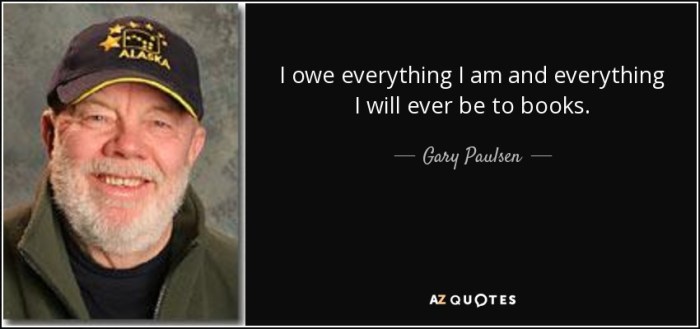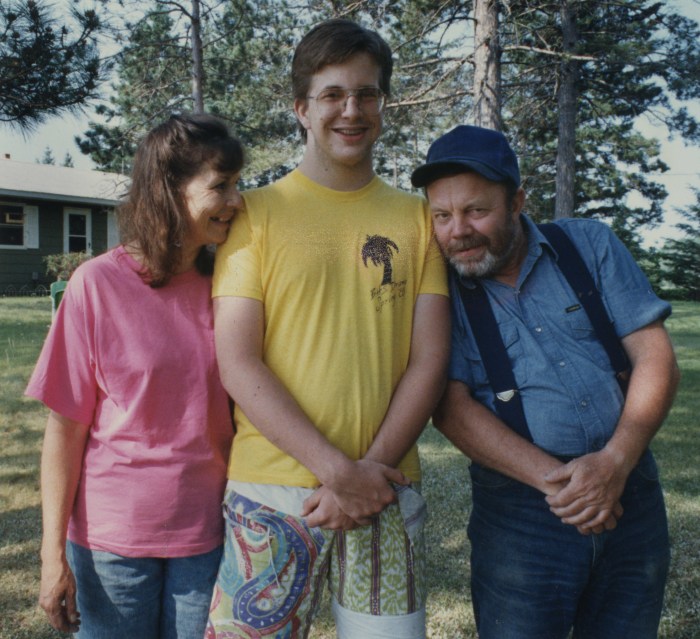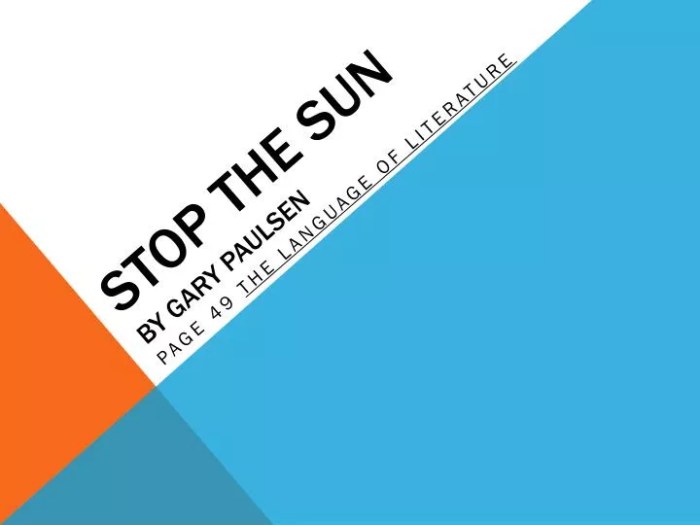Gary paulsen stop the sun – In Gary Paulsen’s gripping novel “Stop the Sun,” we embark on an extraordinary adventure alongside Gary, a young boy lost in the unforgiving wilderness. As he fights for survival, Gary discovers the true meaning of friendship, resilience, and the transformative power of nature.
Through Gary’s journey, we witness the raw beauty of the Alaskan wilderness and the challenges it poses. Paulsen’s vivid descriptions immerse us in a world of towering mountains, treacherous rivers, and untamed wildlife.
Plot Overview

Gary Paulsen: Stop the Sun is a novel by Gary Paulsen that follows the story of Brian Robeson, a thirteen-year-old boy who survives a plane crash in the Canadian wilderness.
Brian is the sole survivor of the crash and must learn to survive on his own in the harsh wilderness. He faces many challenges, including hunger, thirst, and the dangers of the forest. However, Brian is determined to survive and eventually finds his way back to civilization.
Main Characters
The main characters in Gary Paulsen: Stop the Sun are:
- Brian Robeson: A thirteen-year-old boy who survives a plane crash in the Canadian wilderness.
- The pilot: The pilot of the plane that crashes. He is killed in the crash.
- The dog: A dog that Brian finds in the wilderness. The dog helps Brian to survive.
Central Conflict
The central conflict in Gary Paulsen: Stop the Sun is Brian’s struggle to survive in the wilderness. He must overcome many challenges, including hunger, thirst, and the dangers of the forest. However, Brian is determined to survive and eventually finds his way back to civilization.
Character Analysis
In “Stop the Sun,” Gary Paulsen presents a compelling cast of characters that drive the narrative and explore profound themes. The protagonist, Gary Paulsen, embarks on a journey of self-discovery that is both physically and emotionally challenging.
Gary Paulsen, Gary paulsen stop the sun
Gary Paulsen, the protagonist, is a young boy who faces numerous obstacles and hardships throughout the novel. Through his struggles, he learns about resilience, determination, and the importance of human connection. His journey of self-discovery is marked by both setbacks and triumphs, as he gradually comes to terms with his own strengths and weaknesses.
Supporting Characters
The supporting characters in “Stop the Sun” play vital roles in Gary’s journey. His relationship with his father is complex and often strained, but he also finds support and guidance from his friends and mentors. These characters provide him with emotional and practical assistance, helping him to overcome challenges and grow as a person.
Themes
The novel explores several important themes, including friendship, loyalty, and resilience. Gary’s relationships with his friends and family demonstrate the power of human connection and the importance of having a support system. The novel also highlights the value of resilience and perseverance in the face of adversity, as Gary learns to overcome challenges and setbacks through sheer determination.
Setting and Atmosphere

Stop the Sunby Gary Paulsen is set in a remote and desolate region of the Canadian wilderness during the harsh winter months. The unforgiving landscape and extreme weather conditions play a crucial role in shaping the characters’ experiences and the overall plot.
Location
The novel is set in the vast and unforgiving wilderness of northern Canada, where the characters are surrounded by dense forests, frozen lakes, and towering mountains. The remoteness of the location isolates them from civilization and amplifies the challenges they face.
Time Period
The novel takes place during the winter months, when the days are short and the temperatures plummet to extreme lows. The cold and darkness create a sense of urgency and desperation, as the characters struggle to survive in the harsh conditions.
Atmosphere
Paulsen creates an atmosphere of isolation, fear, and uncertainty through his vivid descriptions of the setting. The relentless cold, the howling wind, and the eerie silence of the wilderness combine to create a sense of impending danger and vulnerability.
The characters’ physical and mental struggles are amplified by the unforgiving environment. The cold gnaws at their bodies, the darkness plays tricks on their minds, and the isolation breeds a sense of hopelessness and despair.
Themes and Symbolism
The novel “Stop the Sun” by Gary Paulsen explores several major themes, including:
-
-*Survival
The novel’s protagonist, Paul, faces numerous challenges as he attempts to survive in the wilderness. These challenges include finding food and shelter, dealing with predators, and coping with loneliness and isolation. Through Paul’s experiences, Paulsen explores the human capacity for survival and the importance of perseverance in the face of adversity.
-*Hope
Despite the many challenges he faces, Paul never gives up hope. He believes that he will eventually be rescued and that he will be able to return to his family. This hope sustains him throughout his ordeal and helps him to overcome the many obstacles he encounters.
-*The Power of Nature
The wilderness is a powerful force in the novel. It can be both beautiful and terrifying, and it can have a profound impact on the human psyche. Paul learns to respect the power of nature and to appreciate its beauty.
He also comes to understand that he is a part of nature and that he must live in harmony with it.
These themes are conveyed through the characters and events of the novel. Paul’s experiences in the wilderness illustrate the challenges of survival, the importance of hope, and the power of nature. The novel also uses symbolism and imagery to explore these themes.
For example, the sun is a symbol of hope and renewal, while the darkness is a symbol of despair and danger.
In the adventure novel “Gary Paulsen: Stop the Sun,” a young boy’s quest for self-discovery is set against the backdrop of the unforgiving wilderness. This novel is a captivating tale of survival and resilience that will leave a lasting impression on readers.
If you enjoy stories set in the 20s, you may also appreciate the many musicals set in the 20s , which offer a glimpse into the vibrant culture and music of that era. However, for those seeking a thrilling and immersive wilderness adventure, “Gary Paulsen: Stop the Sun” remains an unforgettable choice.
Narrative Style and Structure: Gary Paulsen Stop The Sun

Gary Paulsen’s writing style in Stop the Sunis characterized by its simplicity and directness. He uses short, declarative sentences and vivid imagery to create a sense of immediacy and realism. The novel’s structure is also notable for its use of flashbacks and different perspectives, which provide a complex and nuanced understanding of the characters and their experiences.
Use of Flashbacks
Paulsen uses flashbacks to reveal the characters’ pasts and motivations. These flashbacks provide insight into the characters’ childhoods, relationships, and traumas, helping the reader to understand their present-day actions and decisions. For example, the flashbacks to Robert’s childhood reveal his abusive relationship with his father, which helps to explain his anger and violence.
Similarly, the flashbacks to Josh’s time in the military shed light on his PTSD and his difficulty adjusting to civilian life.
Different Perspectives
Paulsen also uses different perspectives to provide a multifaceted view of the characters and their experiences. The novel is told from the alternating perspectives of Robert, Josh, and Robert’s daughter, Amanda. Each character has their own unique voice and perspective, which allows the reader to see the events of the novel from multiple angles.
This multi-perspective approach helps to create a more complex and nuanced understanding of the characters and their relationships.
Enhancement of Character and Story Understanding
The narrative style and structure of Stop the Sunwork together to enhance the reader’s understanding of the characters and the story. The use of flashbacks provides insight into the characters’ pasts and motivations, while the different perspectives allow the reader to see the events of the novel from multiple angles.
This complex and nuanced approach to storytelling creates a rich and immersive experience for the reader.
Literary Devices
Gary Paulsen’s Stop the Sunemploys a range of literary devices to captivate readers and enhance the narrative’s impact. These devices serve to foreshadow upcoming events, create ironic juxtapositions, and evoke deeper meanings through the use of metaphors.
Foreshadowing
Foreshadowing is used throughout the novel to hint at future events, building suspense and creating a sense of anticipation. For example, the recurring mention of the “iceberg” foreshadows the tragic accident that befalls the characters.
Irony
Irony is employed to create moments of contrast and highlight the unexpected turns of events. One instance of irony occurs when the characters initially rejoice at finding shelter in an abandoned cabin, unaware that it will ultimately become their prison.
Metaphors
Metaphors are used to draw comparisons between seemingly unrelated concepts, creating vivid and thought-provoking imagery. For instance, the characters’ journey through the unforgiving wilderness is metaphorically likened to a “dance with death,” capturing the perilous and unpredictable nature of their situation.
These literary devices collectively contribute to the novel’s immersive and emotionally resonant storytelling, enhancing the reader’s engagement with the characters’ struggles and the themes explored.
Common Queries
What is the central conflict in “Stop the Sun”?
Gary’s struggle to survive in the wilderness and find his way back to safety.
How does Gary’s relationship with the dog change him?
The dog’s loyalty and companionship teach Gary the importance of friendship and help him overcome his loneliness.
What is the significance of the title “Stop the Sun”?
It symbolizes Gary’s desire to pause time and escape the harsh realities of his situation.